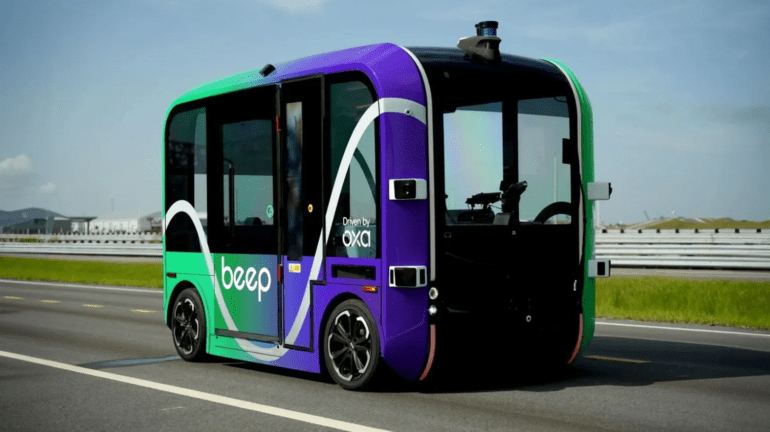TL;DR:
- Oxa, a trailblazing startup, leverages AI to revolutionize autonomous transportation.
- Collaboration with Beep and Google Cloud enables Oxa to control an autonomous fleet for efficient daily commutes.
- Oxa’s innovative technology enters the U.S. through a partnership with Beep, launching autonomous shuttles in Florida.
- The company’s mission: Alleviate road congestion with sustainable urban transit using autonomous shuttles and buses.
- Oxa secures $140 million in Series C funding, supported by notable investors.
- Paul Newman, Oxa’s CTO, aims to reduce highway congestion with autonomous transit solutions.
- Key players like Tesla, General Motors, Ford, and Volkswagen drive the evolution of self-driving vehicles.
- Transparent collaboration with regulators underscores Oxa’s commitment to responsible technological advancement.
- AI’s influence extends to governmental domains with the Pentagon’s Replicator initiative and Kratos Defense’s AI-piloted fighter jet.
Main AI News:
The era of autonomous vehicles is upon us, propelled forward by rapid strides in artificial intelligence. As AI technology gains momentum, its integration into larger vehicles, including mass transit, is becoming a central focus for various companies. Standing at the forefront of this movement is Oxa, a pioneering entity in the realm of autonomous transportation.
During a recent appearance at the Google Cloud Next event in San Francisco, Oxa’s representatives unveiled their visionary approach to autonomous transportation. Collaborating with fellow transportation technology firm Beep and leveraging the extensive toolkit provided by Google Cloud, Oxa aims to achieve a pivotal milestone.
Gavin Jackson, the CEO of Oxa, shared insights on the company’s mission in an exclusive interview with Decrypt. He articulated, “Our mission revolves around furnishing the software capability that effectively manages Beep’s fleet of vehicles. Our goal is to ensure the secure and seamless transportation of individuals to their workplaces and leisure destinations.”
Fresh off the press, Oxa, headquartered in the U.K., has announced a groundbreaking partnership with autonomous shuttle developer Beep. This alliance is set to introduce Oxa’s cutting-edge technology to the United States, commencing with an impressive fleet of autonomous electric shuttles in Florida. The rollout has the potential to encompass various other locations currently served by Beep, encompassing prominent states like California and North Carolina.
Initiating its journey in 2014 under the name Oxbotica, Oxa has garnered significant attention and financial support. A remarkable achievement arrived in January as the company secured a substantial $140 million in Series C funding. Esteemed investors, including Aioi Nissay Dowa Insurance Co., Ltd, ENEOS Innovation Partners, BP Ventures, and other key players, joined hands to endorse Oxa’s transformative mission.
Addressing a pressing concern, Oxa has set its sights on mitigating the congestion plaguing our roads due to a surge in single-occupancy vehicles. The company’s strategy revolves around infusing urban transit with enhanced efficiency and sustainability, enabled by the deployment of autonomous shuttles and buses.
Paul Newman, the visionary CTO and President of Oxa, articulated the company’s strategy, emphasizing the reduction of highway congestion. He cast doubt on the effectiveness of autonomous single-driver cars in combatting the congestion crisis that plagues major cities today. Newman opined, “Autonomy applied solely to personal vehicles or Uber-like robotaxis may not yield substantial improvements but could potentially exacerbate the situation. A holistic perspective is essential for societal progress.”
The inception of autonomous vehicle research dates back to the 1980s when a dedicated team in Munich, Germany, introduced a robotic Mercedes-Benz van. Across the Atlantic, the Defense Advanced Research Projects Agency (DARPA) in the United States catalyzed projects spanning multiple institutions, driving advancements in autonomous vehicle technology.
In the contemporary landscape, the landscape of driverless car manufacturers continues to evolve. Powerhouse companies such as Tesla, General Motors, Ford, and Volkswagen are diligently working to usher in the era of self-driving vehicles.
Paul Newman emphasized Oxa’s unique approach towards regulators, likening them to co-founders. This distinctive stance acknowledges regulators as pivotal partners in facilitating technological progress. Newman stressed the importance of fostering a harmonious social contract and reiterated the significance of transparent collaboration.
Safety and assurance emerged as paramount considerations, as stated by Gavin Jackson. He underscored the value of transparency and collaboration with regulators in cultivating a trusted ecosystem. “Transparency stands as a bedrock principle. Our interaction with regulators is pivotal, as navigating this complex landscape requires concerted effort and open dialogue,” remarked Jackson.
While the revolution unfolds in civilian transportation, AI’s transformative influence extends to governmental domains. Deputy Secretary of Defense Kathleen Hicks recently introduced the Pentagon’s Replicator initiative, seeking to deploy attritable autonomous systems at an extensive scale. Additionally, Kratos Defense, a distinguished U.S. defense company, achieved a milestone with its AI-piloted fighter jet, the XQ-58A Valkyrie, successfully completing its latest flight in July.
Conclusion:
Oxa’s emergence as a frontrunner in AI-driven urban transportation signifies a pivotal shift in the market. The fusion of cutting-edge technology, strategic partnerships, and regulatory collaboration not only redefines daily commuting but also shapes the trajectory of the autonomous vehicle sector. As Oxa paves the way for efficient and sustainable transit solutions, the market is poised for accelerated growth with a heightened focus on safety, transparency, and societal impact.

